Peat formation in Scotland
Fifteen thousand years ago the Scottish Highlands and Islands were in the grip of the last great Ice Age and the region would have looked like Greenland or Spitzbergen today.
This Arctic landscape was dominated by glaciers, bare rock summits and, at lower levels, areas that were ice-free only in summer months. Eventually the climate began to warm and the retreating ice left behind rock fragments and finer glacial deposits that, with time, became primitive soils that plants could get a hold in. This warming period peaked about 8-7000 years ago with the lower riverine valleys supporting dense woodlands of oak and pine, and higher, or less favoured areas, covered by tundra-like vegetation of dwarf willow, birch, sedges and grasses. It is thought that the basic volcanic rocks of the Outer Hebrides supported a more restricted community of trees dominated by thickets of hazel.
Around 7000 years ago there was another major change in climatic conditions with greatly increased rainfall, and it is from this time the great peat formations of the Highlands and Islands began to form. In many areas the increase in rainfall began to permanently waterlog the soil, and the chemical nutrients needed by plants were increasingly washed out - in turn making the soils more acidic. The twin processes of waterlogging and acidification give conditions that resist the normal breakdown and decomposition of dead plants, and this organic material accumulates as deposits of peat.
Peat is defined by the Macaulay Institute as “ An organic soil, which contains more than 60% organic matter and exceeds 50cm in depth”. Peat depth is closely related to the shape of the hard ground, or topography beneath it, with the thickest deposits accumulating over basins and depressions in the rock, and shallower deposits associated with flat or gently sloping areas. Peat is a clear record of past climate and its formation marks boundaries of climatic change.
The peat deposits in the Outer Hebrides are thought to be relatively recent, and their first formation can be estimated in some places from the known age of archaeological remains found beneath them. These dates range from 4300 years ago at Rosinish on Benbecula, to a more recent 2800 years ago at the Calanais Stones monument on Lewis.
All the partially decayed material that makes up the peat constitutes a record of the plant varieties present during formation, with material at depth increasingly difficult to identify. In the Western Isles sphagnum mosses on level ground and heathers on slopes are the major peat-forming plants, though in places significant contributions are made by Deer Grass, Trichophorum cespitosum and Hare’s-tail Cottongrass, Eriophorum vaginatum. Plant species of greater variety, but not quantity, can be found on the uppermost surface layer of peat bogs where the nutrients absent just below the surface are in limited supply originating from recent rainfall, animal input or wind blown sources. Some of the most attractive and more common species (pictured right) are present on the peatlands; however they do not make a significant contribution to the continued build up and accumulation of peat.
Peat Cutting in Uist
Peat used as a fuel to warm the home is now a great deal less common than even 25 years ago. It is unlikely there is now a single house on Uist that is solely reliant on peat for warmth. In the past, before the relatively low cost and availability of other primary sources of fuel like coal, oil and electricity, peat was the most important source of domestic heat available.
For crofting families the annual peat cutting was a time consuming task that could involve the whole family and often the neighbours as well. The job of cutting, drying and transporting the peats home would have equated to about one months full-time work for a man, and this was all done over the Spring and Summer months - a busy time indeed for crofters. The work could be shared out between members of the family, according to ability, with neighbourly co-operation for the heavier work making the task easier. Up to 50 or 60 cart loads of dried peat were needed to keep a croft house in fuel for a year.
Peat banks that are still actively being cut, and old peat workings can be seen all over the island. The best banks are generally those with the deepest profile and the lowest level of cutting produces the blackest, densest peat which burns longer and hotter than peat cut near the surface. The way peats are cut by hand has not changed in generations and the tool, a treisger, is used to slice and lever the chocolatey slabs of wet peat out of the ground, a design perfect for cutting uniform sized peats in quick sucession from the bank. This traditional tool can be found under different names, but with few variations in shape and size, from Orkney to Western Ireland and parts of Wales.
Today the backbreaking task of cutting can be replaced by a machine that takes smaller slabs out of the ground with a device drawn by a tractor, depositing the wet peats on the top of the moorland, without having to cut a face into the bog. These peats can be seen on some of the open ground beside the road that bisects the island (C333) and on first sight appears very odd with no obvious bank from which the peats have been taken. Machine cut peat still has to be rotated and stacked to dry out in the wind before they can be taken home for the fire.
Peat and the archaeological record
The steady accumulation of peat over time captures a record of past climatic conditions and even some major natural events.
In its uppermost layers the plant material that peat is made up from is easily identifiable, whereas at depth the compressed and decomposed remains cannot be identified from basic structures such as leaves or stems. What does survive is the pollen released by flowering plants and trees, and the analysis of these tiny structures can tell the archaeologist what the climate was like when the pollen was produced.
The appearance and disappearance of certain species within the peat column can also be affected by conditions other than climate change. For example, the removal of trees for fuel or as building material by man would result in an absence of tree pollen in the peat; conversely the more recent establishment of large pine plantations will in the future be evident in deposits of pine pollen in the upper-most layers forming today.
Because what falls on the peat surface can in time be incorporated into the peat layer, records of past volcanic events can be created. Fine material is blasted into the high atmosphere by the eruption and is carried sometimes great distances before it falls back to earth. Where peat is being formed downwind of the eruption a layer of volcanic dust is captured in the record. This is the case for the eruptions of the volcano Hekla in Iceland which erupted in 1104 and 1510 and deposited fine ash down on the peatlands of Northern Ireland and Scotland. This airborne ash material is called tephra and is distinctive enough for it to be identifiable to specific eruptions like those of Hekla.



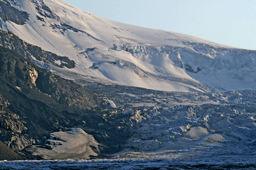 A glacial world
A glacial world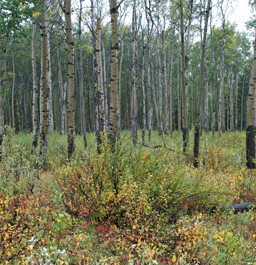 A warmer climate without ice
A warmer climate without ice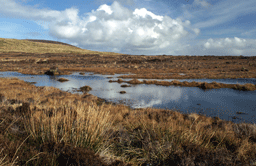 A shift to a wetter climate
A shift to a wetter climate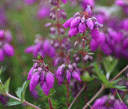 Bell heather
Bell heather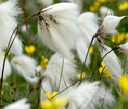 Bog cotton
Bog cotton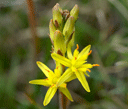 Bog asphodel
Bog asphodel Spooted marsh orchid
Spooted marsh orchid Sundew flytrap
Sundew flytrap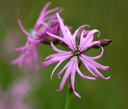 Ragged robin
Ragged robin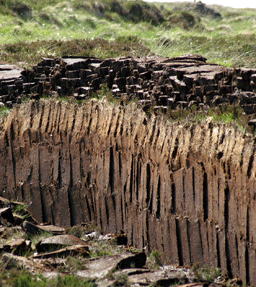 A peat profile of 3000 years
A peat profile of 3000 years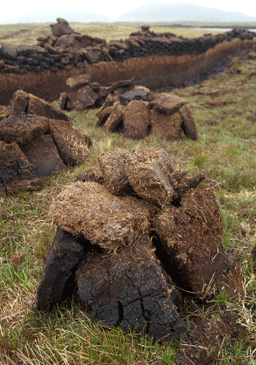 Cut peats drying in the wind
Cut peats drying in the wind Peat burning as a domestic fuel
Peat burning as a domestic fuel